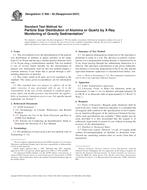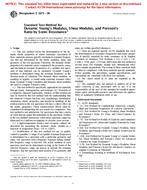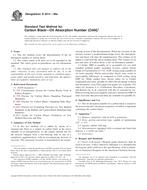1.1 This specification covers five types and two styles of open and one type, and one style of covered wood crates designed for net loads not exceeding 4000 lb [1814 kg]. Open crates are suitable for shipment of items, which are not readily susceptible to damage from outside forces, and which require only limited protection against the elements.
1.2 If environmental protection is necessary, use of a shroud or a covered crate should be considered. With the exception of Type III, Style B crates, the crates included in this specification are for use in domestic and overseas shipment of net loads not over 4000 lb [1814 kg]. Use shall be confined to items falling within the dimensions and weight limitations of the types and grades specified in Table 1.
1.3 In general, Style A crates have heavier components and are to withstand rather severe handling and multiple shipments (heavy-duty), while Style B crates should be confined to handling and shipping that impose only light to moderate hazards on the container (light-duty). Types I, IV, and V crates are general purpose types; Type II crates are designed for items such as ladders, tubing, extrusions, or wallboard which do not require blocking, bracing, or cushioning; and Type III, Style B crates are designed for such self-supporting material as channels, angles, or other structural members where the container serves only as a means for more convenient stacking and handling.
1.4 If the use of other construction methods or techniques is acceptable and permitted (see 5.1.13), the resulting packaging systems shall be of equal or better performance than would result from the use of these specified materials and procedures. The appropriate distribution cycle specified in Practice D 4169 can be used to develop comparative procedures and criteria.
1.5 The values stated in either SI units or inch-pound units are to be regarded separately as standard. The values stated in each system may not be exact equivalents; therefore, each system shall be used independently of the other. Combining values from the two systems may result in non-conformance with the standard.
1.6 This standard does not purport to address all of the safety concerns, if any, associated with its use. It is the responsibility of the user of this standard to establish appropriate safety and health practices and determine the applicability of regulatory limitations prior to use.
TABLE 1 Crate Classification
| Type | Style A, Heavy Duty | Style B, Light Duty | ||||||
|---|---|---|---|---|---|---|---|---|
| Maximum Net Load (lb/kg) | Inside Dimensions, max | Maximum Net Load (lb/kg) | Inside Dimensions, max | |||||
| Length (ft/mm) | Width (ft/mm) | Height (ft/mm) | Length (ft/mm) | Width (ft/mm) | Height (ft/mm) | |||
| I | 250 [113] | 4 [1200] | 3 [900] | 3 [900] | 200 [90] | 4 [1200] | 3 [900] | 3 [900] |
| IIA | 1000 [450] | 12 [3600] | 4 [900] | 2 [450] | No Style B | |||
| III | No Style A | No load or size restriction except as limited by handling methods | ||||||
| IV | 1000 [450] | 6 [1829] | 4 [900] | 4 [900] | No Style B | |||
| VB | 2500 [1125] | 12 [3600] | 6 [1829] | 6 [1829] | 4000 [1814] | 32 [9600] | 6 [1829] | 10 [3000] |
A Items such as ladders, tubing, and extrusions weighing less than 200 lb [90 kg] and not exceeding 20 ft [6000 mm] long, 3 ft [900 mm] wide and 2 ft [600 mm] high may be packed in Type II crates.
B Type V, Styles A and B crates shall be further classified as being either nondemountable or demountable. Type V, Style B crates may be open or covered.
^PDESIG: D6039 ^PYEAR: 2008 ^CLASS: Specification
Product Details
- Published:
- 10/01/2008
- Number of Pages:
- 23
- File Size:
- 1 file , 530 KB
- Redline File Size:
- 2 files , 1000 KB


